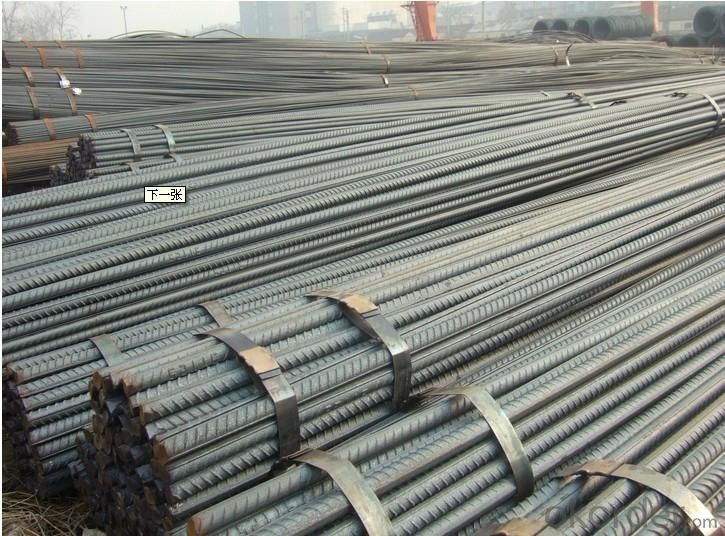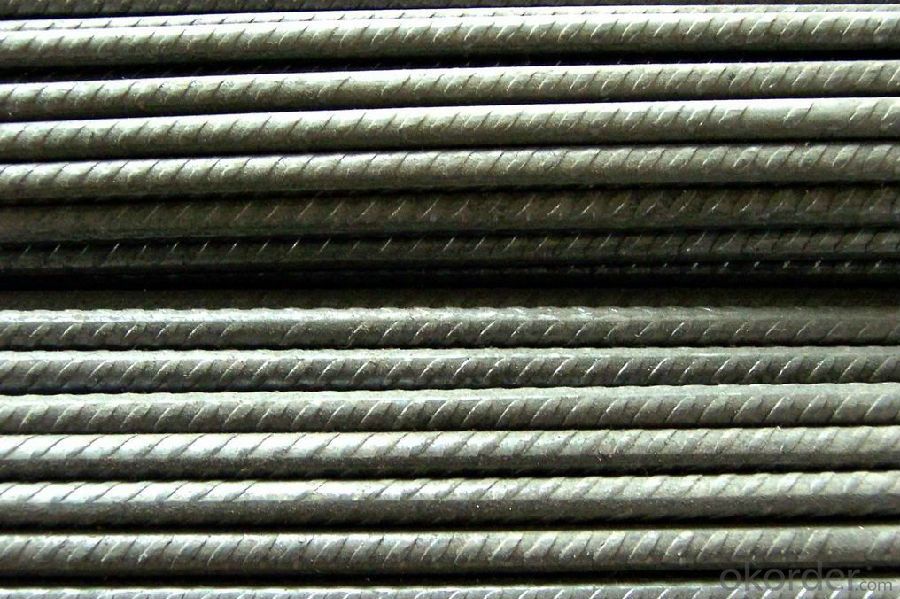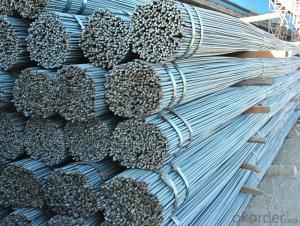Hot Rolled Deformed Bar HRB400 or BS449 B500B
- Loading Port:
- Tianjin
- Payment Terms:
- TT OR LC
- Min Order Qty:
- 25 m.t.
- Supply Capability:
- 200000 m.t./month
OKorder Service Pledge
OKorder Financial Service
You Might Also Like
Product Description:
OKorder is offering Product Description:
OKorder is offering Hot Rolled Deformed Bar HRB400 or BS449 B500B at great prices with worldwide shipping. Our supplier is a world-class manufacturer of steel, with our products utilized the world over. OKorder annually supplies products to European, North American and Asian markets. We provide quotations within 24 hours of receiving an inquiry and guarantee competitive prices.
Product Applications:
Deformed bar is widely used in buildings, bridges, roads and other engineering construction. Big to highways, railways, bridges, culverts, tunnels, public facilities such as flood control, dam, small to housing construction, beam, column, wall and the foundation of the plate, deformed bar is an integral structure material. With the development of world economy and the vigorous development of infrastructure construction, real estate, the demand for deformed bar will be larger and larger
Product Advantages:
OKorder's Hot Rolled Deformed Bar HRB400 or BS449 B500B are durable, strong, and resist corrosion, exact size, regular package, chemical and mechanical properties are stable.
Main Product Features:
· Premium quality
· Prompt delivery & seaworthy packing (30 days after receiving deposit)
· Corrosion resistance
· Can be recycled and reused
· Mill test certification
· Professional Service
· Competitive pricing
Product Specifications:
Manufacture: Hot rolled
Grade: BS4449
Certificates: ISO, SGS, BV, CIQ
Diameter: 6mm,8mm,10mm,12mm,14mm,16mm,18mm,20mm,
22mm,25mm,28mm,32mm,36mm,40mm,50mm
Length: 6M, 9M,12M or as required
Packaging: Export packing, nude packing, bundled
Chemical Composition: (Please kindly find our chemistry of our material based on HRB500 as below for your information)
Grade | Technical data of the original chemical composition (%) | ||||||
C | Mn | Si | S | P | V | ||
HRB400 | ≤0.25 | ≤1.60 | ≤0.80 | ≤0.045 | ≤0.045 | 0.04-0.12 | |
Physical capability | |||||||
Yield Strength (N/cm²) | Tensile Strength (N/cm²) | Elongation (%) | |||||
≥400 | ≥570 | ≥14 | |||||
Theoretical weight and section area of each diameter as below for your information:
Diameter(mm) | Section area (mm²) | Mass(kg/m) | Weight of 12m bar(kg) |
6 | 28.27 | 0.222 | 2.664 |
8 | 50.27 | 0.395 | 4.74 |
10 | 78.54 | 0.617 | 7.404 |
12 | 113.1 | 0.888 | 10.656 |
14 | 153.9 | 1.21 | 14.52 |
16 | 201.1 | 1.58 | 18.96 |
18 | 254.5 | 2.00 | 24 |
20 | 314.2 | 2.47 | 29.64 |
22 | 380.1 | 2.98 | 35.76 |
25 | 490.9 | 3.85 | 46.2 |
28 | 615.8 | 4.83 | 57.96 |
32 | 804.2 | 6.31 | 75.72 |
36 | 1018 | 7.99 | 98.88 |
40 | 1257 | 9.87 | 118.44 |
50 | 1964 | 15.42 | 185.04 |
FAQ:
Q1: How do we guarantee the quality of our products?
A1: We have established an advanced quality management system which conducts strict quality tests at every step, from raw materials to the final product. At the same time, we provide extensive follow-up service assurances as required.
Q2: What makes stainless steel stainless?
Within three days of placing an order, we will begin production. The specific shipping date is dependent upon international and government factors, but is typically 7 to 10 workdays.
Q3: What makes stainless steel stainless?
A3: Stainless steel must contain at least 10.5 % chromium. It is this element that reacts with the oxygen in the air to form a complex chrome-oxide surface layer that is invisible but strong enough to prevent further oxygen from "staining" (rusting) the surface. Higher levels of chromium and the addition of other alloying elements such as nickel and molybdenum enhance this surface layer and improve the corrosion resistance of the stainless material.


- Q:Can steel rebars be cut on-site during construction?
- Yes, steel rebars can be cut on-site during construction. This process, known as rebar cutting, is commonly done to achieve the desired length or shape of the rebars to meet specific project requirements.
- Q:Are there any safety concerns related to handling steel rebars?
- Yes, there are safety concerns related to handling steel rebars. Steel rebars are heavy and can cause strain or muscle injuries if not lifted properly. It is important to use proper lifting techniques and equipment such as gloves, back supports, and lifting tools to prevent injuries. Additionally, sharp edges on rebars can pose a puncture or laceration hazard, so it is crucial to wear appropriate protective clothing such as steel-toed boots and gloves. Workers should also be cautious of tripping hazards caused by rebars lying on the ground. Proper housekeeping and keeping the work area clear can help prevent accidents. Lastly, working with rebars involves the use of power tools such as cutting saws, which can generate noise, dust, and debris. Adequate hearing protection, dust masks, and eye protection should be worn to minimize these risks. Overall, following safety guidelines and proper procedures is crucial when handling steel rebars to prevent accidents and injuries.
- Q:Can steel rebars be used in bridge construction?
- Yes, steel rebars are commonly used in bridge construction. They provide strength and reinforcement to the concrete used in bridge components such as beams, columns, and foundations. Steel rebars enhance the structural integrity and load-bearing capacity of the bridge, making it a durable and long-lasting infrastructure.
- Q:What are the different types of coatings available for steel rebars?
- There are several types of coatings available for steel rebars, including epoxy, galvanized, and black oxide coatings. Each type of coating provides different levels of protection against corrosion and helps to extend the lifespan of the rebars in various environments.
- Q:How are steel rebars classified based on their shape?
- There are several types of steel rebars that are classified according to their shape. The most commonly used ones include plain round bars, deformed bars, square bars, and ribbed bars. Plain round bars are the simplest and most frequently utilized type. They have a smooth and round surface without any deformations or ribs. These bars are typically employed in cases where minimal reinforcement is needed for the concrete structure. Deformed bars, on the other hand, have ribs or deformations along their length. These ribs enhance the bond between the steel and the concrete, thereby improving structural integrity and preventing slippage. Deformed bars can be further classified based on the pattern and profile of the ribs, such as deformed high yield bars, twisted bars, and TMT (Thermo-Mechanically Treated) bars. Square bars, as their name suggests, have a square cross-section. They are mainly used in situations where additional strength and rigidity are required. Square rebars distribute loads better and are commonly utilized in building foundations, columns, and beams. Ribbed bars, also known as deformed square bars, have a square cross-section with ribs or deformations along their length. These ribs enhance the bond between the steel and the concrete, thereby providing better resistance against shear forces and improving overall structural strength. Ribbed bars are frequently used in reinforced concrete structures, such as bridges, highways, and buildings. To summarize, steel rebars are classified based on their shape into plain round bars, deformed bars, square bars, and ribbed bars. Each type of rebar offers distinct characteristics and is chosen based on the specific requirements and load-bearing capacity of the concrete structure.
- Q:How do steel rebars affect the shrinkage and creep of concrete?
- Concrete's shrinkage and creep behavior can be significantly influenced by steel rebars. Shrinkage refers to the concrete's volume reduction caused by moisture loss during drying, while creep refers to its time-dependent deformation under sustained load. The inclusion of steel rebars helps mitigate concrete shrinkage. As the concrete shrinks, the rigid rebars resist this reduction and provide restraint. This restraint minimizes volume changes and reduces cracking caused by shrinkage. Moreover, the tensile strength of rebars allows them to distribute stress and prevent localized cracking, further minimizing the impact of shrinkage on overall concrete performance. Regarding creep, steel rebars can increase concrete's deformation. This is because the rebars introduce additional stress and strain, leading to greater creep deflections. However, compared to factors like mix design, water-cement ratio, and curing conditions, the effect of steel rebars on creep is generally considered minor. It's important to note that proper reinforcement layout design and detailing can minimize the impact of steel rebars on shrinkage and creep. Adequate spacing, rebars cover, and reinforcement ratios optimize both concrete and rebars' performance. Additionally, the use of supplementary cementitious materials like fly ash or silica fume can reduce shrinkage and mitigate creep's impact. In summary, steel rebars are crucial in minimizing concrete's shrinkage-related issues through restraint and stress distribution. Though they may increase creep deformation, their impact is generally minor compared to other factors. Proper reinforcement design and detailing optimize concrete and steel rebars' performance in terms of shrinkage and creep.
- Q:Can steel rebars be used in architectural concrete elements?
- Indeed, architectural concrete elements can incorporate steel rebars for reinforcement, thereby augmenting the strength and longevity of the structure. It is customary to employ steel rebars in concrete construction as they fortify the concrete and enhance its durability. In the realm of architectural concrete, rebars can be tactically positioned to fortify the structural integrity of the elements, while simultaneously contributing to their visual appeal. Depending on the desired design outcome, these rebars can either be visibly exposed or discreetly concealed within the concrete. By utilizing steel rebars, architects possess the versatility to fashion intricate and distinctive architectural elements, all the while ensuring the requisite strength and stability.
- Q:Can steel rebars be used in bridges and highways?
- Yes, steel rebars can be used in bridges and highways. Steel rebars are commonly used as reinforcement in concrete structures, including bridges and highways, to enhance their strength and durability. The rebars are embedded within the concrete to provide additional tensile strength, which is crucial for withstanding the various loads and stresses that bridges and highways are subjected to. Steel rebars are preferred due to their high strength-to-weight ratio, corrosion resistance, and ability to bond well with concrete. Additionally, they can be easily fabricated and shaped to suit the design requirements of the bridge or highway. Overall, steel rebars are a vital component in the construction of bridges and highways, ensuring their structural integrity and longevity.
- Q:How to calculate the theoretical elongation of finishing thread steel?
- The theoretical elongation of fine thread steel is calculated by L=P.L/ (E.A), P is force, L steel bar is longer, E is elastic, and A is area.
- Q:What are the guidelines for the proper anchoring of steel rebars in walls?
- To ensure the structural integrity and stability of the construction, it is crucial to properly anchor steel rebars in walls. Here are some guidelines to adhere to for the correct anchoring of steel rebars in walls: 1. Determine the necessary rebar size and spacing: The design specifications and load requirements dictate the size and spacing of rebars. Consult a structural engineer or refer to building codes for the appropriate rebar size and spacing. 2. Clean and prepare the concrete surfaces: Prior to anchoring the rebars, ensure that the concrete surfaces are clean and devoid of dust, debris, and loose material. Utilize a wire brush or compressed air to eliminate any contaminants. 3. Employ appropriate anchoring techniques: The most widely used method for anchoring steel rebars in walls is embedding them into the concrete. Ensure secure embedding by following these steps: a. Drill holes: Drill holes in the concrete wall at designated locations and depths, ensuring the hole diameter matches the rebar size. b. Clean the drilled holes: Utilize compressed air or a brush to remove any dust or debris from the drilled holes. c. Insert rebars: Insert the rebars into the drilled holes, making sure they reach the required embedment depth. d. Maintain proper spacing: Follow design requirements to maintain the specified spacing between rebars. e. Secure rebars: Use suitable anchoring materials like epoxy resin or grout to secure the rebars in place. Adhere to the manufacturer's instructions for mixing and applying the anchoring material. f. Verify proper alignment: Before the anchoring material sets, ensure the rebars are correctly aligned both horizontally and vertically. 4. Allow sufficient curing time: After anchoring the rebars, allow ample time for the anchoring material to cure. This guarantees that the rebars are firmly secured in place. 5. Adequately protect the rebars: Once the rebars are anchored, protect them from corrosion by applying a suitable corrosion-resistant coating or by using corrosion-resistant rebars. It is imperative to adhere to these guidelines, as improper anchoring of steel rebars can compromise the structural integrity of the walls and pose safety risks. Always consult a qualified structural engineer or building professional for specific guidelines tailored to your project.
1. Manufacturer Overview |
|
|---|---|
| Location | |
| Year Established | |
| Annual Output Value | |
| Main Markets | |
| Company Certifications | |
2. Manufacturer Certificates |
|
|---|---|
| a) Certification Name | |
| Range | |
| Reference | |
| Validity Period | |
3. Manufacturer Capability |
|
|---|---|
| a)Trade Capacity | |
| Nearest Port | |
| Export Percentage | |
| No.of Employees in Trade Department | |
| Language Spoken: | |
| b)Factory Information | |
| Factory Size: | |
| No. of Production Lines | |
| Contract Manufacturing | |
| Product Price Range | |
Send your message to us
Hot Rolled Deformed Bar HRB400 or BS449 B500B
- Loading Port:
- Tianjin
- Payment Terms:
- TT OR LC
- Min Order Qty:
- 25 m.t.
- Supply Capability:
- 200000 m.t./month
OKorder Service Pledge
OKorder Financial Service
Similar products
New products
Hot products
Related keywords





























